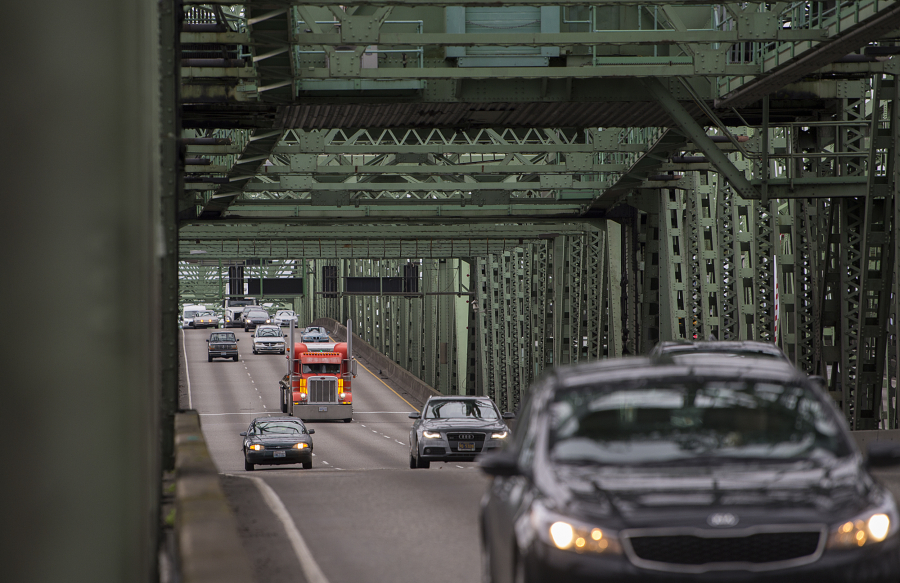The Interstate Bridge Replacement Program’s ambitious timetable calls for the bistate project’s office to produce a single recommended configuration for a replacement Interstate 5 Bridge in as little as four months, releasing the plan publicly in January.
Officials from Vancouver, Portland, Metro and other regional governments and agencies generally appeared to be on board with the compressed schedule at a Wednesday morning meeting of the program’s Executive Steering Group, but several members urged the project staff to make sure the selection process remains comprehensive enough to avoid any surprise issues popping up later.
Group members repeatedly pointed to the Oregon Department of Transportation’s plan to implement congestion pricing tolls on large sections of Interstates 5 and 205 as a factor that could later undermine the recommended bridge configuration if the selection process doesn’t adequately account for how congestion pricing could impact traffic crossing the river.
The recommended configuration will seek to answer four primary questions about the project, according to program administrator Greg Johnson: how many lanes the new bridge will carry, what kind of high-capacity transit will cross it, whether it will include a direct interchange on Hayden Island and whether the project will also replace the harbor bridge that carries I-5 from mainland Oregon to the island.
The mothballed Columbia River Crossing project had settled on a preferred alternative that reused the harbor bridge, Johnson noted, but he said that enough time had gone by to prompt the Interstate Bridge Replacement Program office to reevaluate that part of the plan in order to make sure the overall corridor is in “seismic sync.”
Project staff have spent the summer identifying design options and developing screening criteria, IBR environmental manager Chris Regan told the steering group members, as well as gathering data for use in modeling.
The office’s goal is to screen the options in November and December and arrive at a single recommendation to be presented in January, then developed and refined in the following four months in preparation for the NEPA process.
Speed concerns
Multiple members of the steering group quizzed Johnson about plans for the next few months, raising concerns about factors that they wanted to make sure would be included in the screening process.
Metro President Lynn Peterson said she wanted assurance that the screening criteria would be fully developed and understood, with opportunity for the steering committee and other groups to weigh in before the selection of a recommended configuration.
Portland Bureau of Transportation Director Chris Warner cautioned that his office would need to be able to keep the Portland City Council up to date on the screening process, which would be difficult to do unless the screening criteria includes clearly defined outcomes to measure for each possible configuration.
Vancouver Mayor Anne McEnerny-Ogle noted that members of the Vancouver City Council also sit on the C-Tran board of directors and the Southwest Washington Regional Transportation Council, and would need sufficient time to report back to those groups and gather input from them when it comes time to discuss specific options such as the transit mode and number of lanes on the bridge.
Warner also expressed concern that the steering group had not yet discussed how ODOT’s plan for regional congestion pricing would intersect with the bridge plan. Congestion pricing could impact both the financing of the bridge and the ideal lane configuration, he said, and those impacts need to be accounted for in the models and criteria used to determine the recommended configuration.
McEnerny-Ogle echoed his concerns, and Peterson stated that the Metro council would be unable to make an informed decision about the bridge configuration if the congestion pricing issue didn’t come up until a later discussion about financing options. The bridge and congestion pricing projects will need to be very closely coordinated, she said.
“I think this is the moment that we’ve all been waiting for, of like, how do we bring these things together?” she said.
TriMet Engineering and Construction Director Steve Witter also urged the project staff to make sure their schedule matches the timing of the Federal Transit Administration’s capital investment grant process.
Johnson said the project office would coordinate with both ODOT and the federal government in the coming months and that congestion pricing impacts would be factored into the models for screening. ODOT Director Kris Strickler said the agency agreed that the project timelines would need to be closely coordinated.
Eliminating alternatives
Wednesday’s meeting included a presentation from deputy program administrator Ray Mabey about alternative crossing options, centering on four common suggestions that he said the project office investigated in recent months: a third bridge, a high-speed rail crossing, a tunnel and the “Common Sense Alternative II,” a package of supplemental improvements and additions to existing bridges, including the nearby rail bridge.
The office evaluated each idea using the project’s Purpose and Need statement, he said, which outlines six primary problems with the existing I-5 crossing that the preferred alternative must address: congestion, impaired freight movement, limited public transportation, safety, limited bike and pedestrian access and seismic vulnerability.
“Any alternative that is considered has to meet those six needs,” he said, and none of the suggested ideas could fully do so.
A tunnel would be twice as expensive as a new bridge, he said, and the portals would need to be set back a considerable distance from the river in order for the tunnel to achieve the necessary depth at an acceptable slope, which would make it impossible for it to directly connect with Hayden Island and downtown Vancouver.
The other three alternatives would all leave the existing I-5 Bridge in place, he said, and would therefore fail to solve the current bridge’s safety issues, seismic deficiencies and poor bike and pedestrian access. The alternatives had all been considered and rejected during the CRC planning process for similar reasons, he noted.
Mabey and Johnson both stressed that eliminating the alternatives from consideration does not mean that they’re all impossible or that they couldn’t be considered as part of some separate future project, such as a regional high-speed rail line.
“It doesn’t mean that they weren’t good ideas, but they don’t meet all of the purpose and need for what we’re trying to solve here,” Peterson added.




